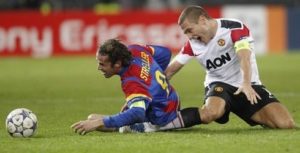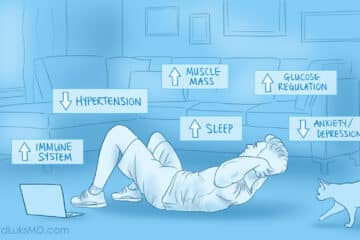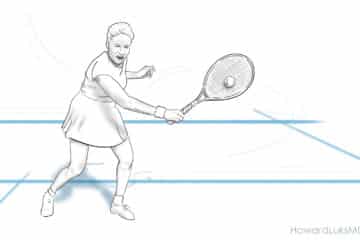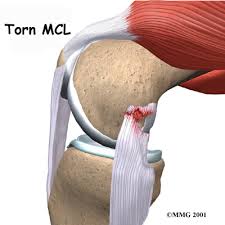
MCL or medial collateral ligament injuries of the knee are a relatively common injury. The MCL is one of the most commonly torn ligaments around the knee. The vast majority of knee MCL tears will not require surgery, but they can take many months to recover from. The severity of your MCL injury or the “grade” of your injury (discussed below) will influence what MCL treatment we need to consider and what your recovery time will be. Most all athletes will return to sports following an MCL tear.
Watching Cristiano Ronaldo go down early in the 2016 UEFA tourney was a shock to many. He tried many times to return, but was eventually taken off on a stretcher. He deserved an enormous amount of credit for trying to continue playing because MCL sprains tend to be a very painful injury.
What is the MCL ?
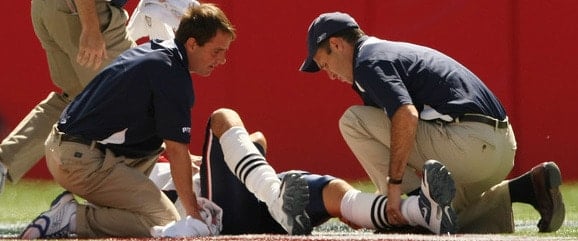 What is the MCL and why will it often take 8-10 weeks to return to sports?
What is the MCL and why will it often take 8-10 weeks to return to sports?
The MCL is one of the 4 major ligaments in the knee. Ligaments connect two bones to one another. The MCL or medial collateral ligament is on the inner side of your knee. It is responsible for preventing the knee from caving inward.
The MCL can be injured by being struck on the outside of your knee, or by certain twisting injuries. Players can suffer an MCL tear with contact injuries or with non-contact twisting injuries.
Often times knee injuries only involve the MCL itself, but there are times when the injury involves more than one ligament, such as combined MCL/ ACL tears.
What are the symptoms of an MCL tear?
The most common symptom of an MCL tear is feeling a snap or a pop on the inner side of your knee after you were struck. Pain is the most common symptom. Swelling of the knee can also occur in more severe injuries to the MCL, or if you injured the ACL at the same time. The pain is often located along a prominent bone on the end of the femur along the inner side of your knee. Most people with MCL tears or sprains will not complain of instability. In situations where you had a severe MCL injury (Grade 3), or if you have injured the ACL and MCL the knee will feel unstable. In these situations the athlete tries to get up and walk after the injury only to have the knee cave in and feel loose. That athlete is usually carried off the playing field.
How to diagnose an MCL tear
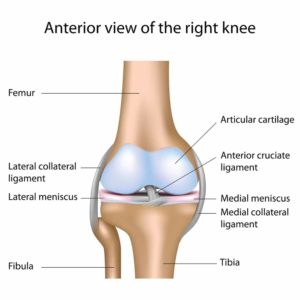
How severe is my MCL injury?
We grade the severity of an MCL tear between a Grade I and a Grade III.
- Grade I tears are the least severe. Grade 1 injuries involve a stretch or a strain of the MCL. An exam should reveal a stable knee, but pain when touching the MCL.
- Grade II injuries involve a partial tear of the MCL ligament. A knee with a Grade II tear will feel a little loose, but should not feel unstable.
- Grade III MCL tears are complete tears. That means the ligament has completely torn into two separate pieces. Many people with grade III injuries will also have an injury to the ACL or PCL. We discuss combined ACL and MCL injuries here. Grade III MCL tears usually result in a very unstable knee. Every time you try to walk or run the knee will cave inward and feel unstable.
Treatment of MCL Tears
The treatment of MCL injuries depends upon the severity or grade of the injury.
- Grade I MCL tears will require you to use crutches only until you are comfortable. Grade I injuries do not typically require a brace for healing purposes, but a brace may make your knee more comfortable. Physical therapy should be started promptly for two reasons. Injuries around the knee can cause atrophy or weakness of the muscles. That can happen very rapidly. In addition, MCL injuries cause stiffness. The sooner you start the therapy, the sooner your strength and motion will return to normal.
- Grade II partial MCL injuries will also require crutches for a week or two. They are mostly for comfort. A brace is generally used if the knee feels a little loose on examination. The brace will protect the ligament while it is healing. Grade 2 MCL tears do not require surgery.
- Grade III injuries are complete tears of the MCL. Many of these complete tears will require surgery to reattach the two torn ends of the ligament. Sometimes the ligament tears off the bone, and in those repairs we will reattach the ligament to the bone. During the surgery to repair an MCL tear we make a small incision at the site of the tear. We will identify where the ligament tear from the bone and reattach it with a number of stitches. Grade III MCL tears are rare.
- Grade III MCL and ACL tears: If you have a combined rupture of the MCL and the ACL then we will usually need to repair the MCL at the same time we reconstruct the ACL. There are also occasions where we will repair the MCL and then wait until the ligament heals before reconstructing the ACL. Recent surgical advances have allowed us to repair the MCL using smaller incisions and an internal brace created by a strong suture so that we can start the rehabilitation soon after the surgery.
Recovery from an MCL tear
MCL injuries can take a long time to feel better. The main problem with MCL injuries is that they hurt. They tend to hurt more than any other ligament injury around the knee. The inner side of the knee does not tolerate injuries well. Even a Grade I MCL tear may knock you out of commission for 2-3 months. Sometimes the pain continues long after the ligament tissue has healed. Patients with a grade I MCL tear can return to sports as soon as the knee feels strong and your motion is normal.
Recovery from a grade II partial MCL tear will take a little longer than a grade I to heal. These tears do not require surgery, so the sooner you start your physical therapy, the sooner you can return to sports. Most patients with a grade II MCL tear will return to sports within 2-4 months. Once again, you need to sure you have normal motion, strength and agility before returning to sports.
Do you have questions regarding an Orthopedic injury or longevity?
Do you want to talk to an expert who can listen to you for 45-60 minutes and explain the options in detail?
Dr. Howard Luks offers remote guidance sessions to review your X-ray or MRI images and explain your options.
Dr. Luks has also received hundreds of requests for educational sessions on the topics discussed in his book, Longevity Simplified.
Grade III complete MCL injuries which required surgery will take much longer to heal. These injuries will also take much longer to recover from. The surgery will cause more stiffness and more muscle atrophy. The ligament is usually healed within a 6-8 weeks. But your recovery is not complete until your motion, strength and agility return to normal. This diminishes the chance of a recurrent injury, or worse, an injury to the ACL.
Physical therapy and working on getting your motion back is critical as soon as your doctor tells you that the ligament is healed enough. It can take a long time to get back full range of motion. MCL injuries, although usually treated without surgery can hurt for months and take many months to recover from. Once your motion is restored then you need to work on agility drills. Moving side to side can hurt for many months because it pulls on the healing MCL tear.
Thankfully most MCL tears do not require surgery, and most athletes will return to sports. Some will be able to return in the same season. Physical therapy and working on diminishing swelling, inflammation and pain are critical once you get the go ahead to do so.
